Red Hot & Blue - Blue Topaz

- See also Topaz Blue and Déjà Vu by Robert Weldon
- Skip to Gems & Gemology: Blue Topaz (decay rate) (3/15/12)
- Skip to Déjà blue all over again (10/18/11)
- Skip to Market Blah about Topaz Blue (11/19/08)
- Skip to Irradiated Gemstone Testing License Issued (10/22/08)
- Skip to Irradiated Gemstones: Licensee Announced, Guidelines Released (8/21/08)
- Skip to Irradiated Topaz: Something old, new, borrowed, blue (2/21/08)
- Skip to Radiation Safety Consultant Addresses Blue Topaz (1/16/08)
- Skip to NRC Won’t Take Action on Blue Topaz Inventories (12/16/07)
- Skip to NRC Issues Distribution Licenses for Irradiated Gemstones (12/16/07)
- Skip to NRC: Bride of Franken-stone No More (10/15/07)
- Skip to NRC Tests Blue Topaz; No Health Threat, No Sign-off (8/10/07)
- Skip to Blue Topaz NRC Meeting Summary (8/1/07)
- Skip to AGTA Issues Blue Topaz White Paper (7/26/07)
- Skip to NRC Confronts Blue Topaz Issue (7/23/07)
- Skip to Son of Franken-stone: An Update on Irradiated Gemstones (5/15/07)
- Skip to Red Hot and Blue: Irradiated Blue Topaz (12/14/06)
December 14, 2006. Some time back we became aware of the issue of residual radiation being detected in faceted blue topaz. We looked into the matter and provide the following discussion as a starting point for further inquiry.
Blue Topaz?
Topaz is most common in colorless and brown colors. Blue topaz is achieved by a combination of irradiation—which can turn the material brown—and heat treatment, if needed—which renders the stone blue.
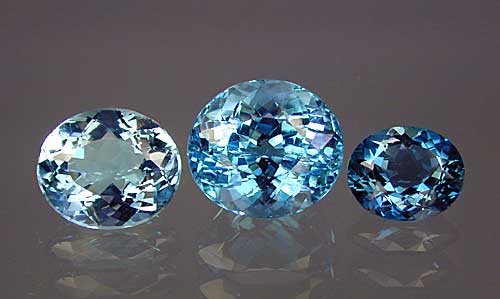 |
| Three different examples of treated blue topaz. (Photo: Wimon Manorotkul) |
According to Professor Jill Banfield of UC Berkeley, nuclear reactors “create an intense blue [in topaz] (that does not need secondary heat treatment).” Other irradiation methods require the heat treatment to achieve blue color.
(A description of the chemical process can be found on this Oak Ridge Associated Universities website, and a list of various irradiation methods on this University of Texas website. Our own Topaz Buying Guide also contains some information about treatment.)
 |
| Electron linear accelerator (“linac”) console at the Rensselaer Polytechnic Institute’s Gaerttner Laboratory. |
Safety Issues
The decay rates of isotopes created by irradiation depend on the individual isotope. References on the Web discuss length of decay to be anywhere from hours to days to years. A lively discussion on GemologyOnline.com provides a snapshot of the complexity of the science. A presentation by Douglas J. Parsons at last year’s biennial International Gemological Conference discusses irradiation, and specifically topaz irradiated via nuclear reactor (on page 2).
Although electron beam linac irradiated topaz presents no danger to the general public, neutron-irradiated topaz treated in a nuclear reactor facility can present a potential health hazard, if not properly controlled. This differentiation between treatment technologies is fundamental and important. The impurities (i.e. elements) in topaz become quite radioactive when bombarded by neutrons in a nuclear reactor; and must be monitored carefully. Typical topaz impurities which result in activation products with longer half-lives include tantalum, scandium and manganese. Depending on the length of time the topaz was bombarded by neutrons, it might be several months to several years before such material reaches a releasable level of activity. The bright blue topaz referred to as "Swiss Blue" is created by first bombarding the topaz with neutrons in a nuclear reactor, then irradiating the same topaz with electrons using an rf linac, and then heat treating the topaz in ovens. The normally clear natural topaz becomes an ugly green/brown shade after neutron bombardment, so that its neutron treatment is readily apparent to the eye. This gross discoloration is generally a good indication that radiation monitoring is necessary before handling the material further. Generally, such topaz is not released from the nuclear reactor facility until it has reached an acceptable, legal activity level. It is then sent to a linac facility for electron beam treatment, followed by heat treatment.
Obviously, this raises safety issues regarding the handling of irradiated material, which include:
- Rough material (irradiation is performed on rough almost exclusively) being faceted before safe levels are reached, thus endangering gemstone cutters who could inhale atomized water/dust
- Material being shipped in ignorance of—or defiance of—government regulation, endangering handlers
- Drop shipping of irradiated material from remote suppliers, by resellers who never see material, endangering the recipient
Regulation
In the fall of 1990, the Nuclear Regulatory Commission (NRC) issued Information Notice No. 90-62: Requirements for Import and Distribution of Neutron-Irradiated Gems. It is a reiteration of “long-standing” NRC requirements, specifically in reaction to distribution of blue topaz in the U.S. “without NRC authorization.”
A special NRC license is required for distribution of such gems to unlicensed persons (such as gem dealers, wholesalers, and consumers). In early 1988, NRC informed all gem industry representatives and non-power reactor licensees that NRC would accept applications for such licenses to distribute neutron-irradiated gems (see Attachments 1 and 2). The license requirements are contained in 10 CFR Parts 30 and 32.
Licensed distributors must have radiation measurement and quality control procedures for ensuring that all gems released to the public are below the radioactivity limits specified in 10 CFR 30.70. The distributors must disclose to their customers that gems are neutron-irradiated. The licenses authorize distribution of cut, finished gems only, because radiation exposures associated with cutting and grinding gems are potentially much higher than those incurred through normal consumer use.
The notice goes on to mention three licensees, and one pending, as of 9/1/90. We’ve been told, however, that according to the NRC there are no active licenses at this time. If this is indeed the case, it means that there is no legally recognized channel for the importation of blue topaz in the U.S. today. This notice applies only to topaz treated in nuclear reactors; linear accelerator treatment is regulated by state agencies.
Self-Regulation
Of course, blue topaz is on the market, as a quick search on eBay demonstrates. We should note here that our confidential source believes that even though some of this material exceeds the limits mentioned in the NRC notice, the limits themselves are so low that a moderate infringement is not likely to cause ill effects.
And the issue of residual radiation is of concern to industry players. We’ve been told of a recent attempt by an informal group of interested parties to address the issue. This week, however, we were informed that this group appears to have decided to approach the issue individually rather than collectively.
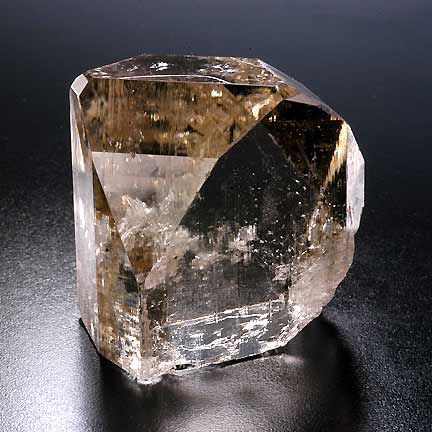 |
| Natural topaz crystal. The brown cast seen here in this untreated crystal can be accentuated by some radiation treatments, then turned blue by heating. This unenhanced specimen was acquired by Pala’s Bill Larson at this year’s Sainte-Marie-aux-Mines show. (Photo: Wimon Manorotkul) |
One suggestion we received while researching this story: less than $800 will buy a unit that measures background radiation. (PC-based units can cost even less.) While such a device won’t measure radiation within NRC statutory limits, nor will it identify isotopes, it can at least raise a flag if, for example, a specimen registers 20–60 times above background. The material then can be tested by the nuclear health divisions of the states that offer nuclear safety testing.
Questions Raised
Given the fact that the relatively few industry stakeholders impacted by the blue topaz issue appear reluctant to address it in a concerted way—at least at present—we can only ask whether they hope the matter will just go away. The fact that gemstone-enhancing nuclear reactors are, as we understand it, proliferating in countries that may not adequately restrict the flow of “hot” material leads us to believe that the issue of safety will become more—not less—acute. Will it take a spotlight drawn on, say, the health effects from years of cutting hot stones, to finally bring about unified action? Such a scenario has some players seeing red—because such scrutiny could be avoided by making the right efforts today.
Feedback on this story is encouraged.
Son of Franken-stone: An Update on Irradiated Gemstones
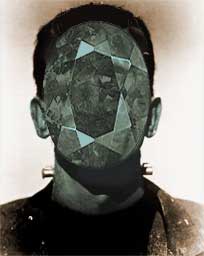 |
May 15, 2007. In our December 2006 story above, “Red Hot and Blue: Irradiated Blue Topaz,” we raised safety issues regarding the possibility of neutron-irradiated topaz being released to dealers and gemstone cutters before residual radiation has reached safe levels. We also discussed U.S. government regulation, which effectively bans the importation of (neutron-irradiated) blue topaz. And because it appears that imported blue topaz is becoming available in the U.S. despite the ban, we looked at the reluctance by industry players to consider self-regulation in order to insure that “hot” material is given time to achieve safe radiation levels.
We’ve received a couple of responses to this story. One reader, a trade member from Thailand, raised the issue of irradiation of gemstones other than topaz. Additional feedback came from a prominent scientist who questioned why we were resurrecting the issue of “Franken-stones” when it had been settled in the 1980s by government action both here and abroad.
So we asked John Emmett—an expert in the physics, chemistry, and heat treatment of corundum—to respond to the issues put forward by the readers. He goes into more detail than we did above about how neutron irradiation causes residual radiation in gemstones. He also weighs in on whether government intervention has been entirely successful.
And we thought it might be time to contact our industry insider to find out whether there had been movement regarding self-regulation on safety issues. Finally, we noticed a Modern Jeweler article last month by David Federman, regarding a new topaz enhancement that’s an alternative to irradiation.
Irradiation 101 – A refresher course
Our reader in Thailand urged that, in addition to irradiated topaz, “let’s not forget, the following are regularly irradiated as well: ‘green’ amethyst, citrine, fluorite, heliodor, kunzite, smoky quartz, and... imperial topaz.”
Fortunately these materials usually are treated using methods that produce no residual radiation. John Emmett explains:
There are large cobalt 60 sources in this country and in others. These sources are used, for example, for large scale sterilization of medical supplies.... Essentially, any sterile product today is completely packaged and the the packages are driven past the source on railroad tracks.
There is a large facility in Tustin, California, which... operates under the name of Sterigenics, Inc. This company will also irradiate gemstones. Typically, tourmaline, quartz of all varieties, kunzite, and some topaz are treated with such a source. There is essentially no residual radiation in the product, which is why NRC allows this form of sterilization for nearly any product. Unfortunately colorless topaz is only rendered a light blue by this process.
Using the example of topaz, Emmett explains the process whereby irradiated gemstones may retain unsafe residual radiation levels.
The neutron irradiation “activates” some of the impurities in the topaz. By activates we mean transmutes them into a different isotope of the element or a different element. These new isotopes or new elements are often exceedingly radioactive. Radioactive materials are described by a half life, which is the time that it takes half of the material to decay away (and the radiation level to decrease by half). Half lives can range from fractions of seconds to thousands of years.
In the case of the colorless topaz irradiation it was found that the impurities that activated varied greatly from deposit to deposit. Thus some material was safe by NRC criterion for release after a few weeks, while other material could not be released for years.
Such irradiation was performed in the United States, but was found to be impractical. Emmett discusses the experience of the University of Missouri, which performed neutron irradiation of topaz under NRC license.
A lot of neutron irradiation of topaz was done at the University of Missouri.... They developed equipment to carefully measure the radiation level of each stone individually. What they found is that a lot of material could be released in a few weeks or months but a lot of material would have to be stored for many years. The dealers who owned the hot material abandoned it and the school was faced having to maintain storage or pay the large costs of radioactive material disposal. As a result they abandoned the program of topaz irradiation for release in the US.
So, generally, the gemstone material of concern is neutron-irradiated blue topaz and not, for instance, linac-treated kunzite.
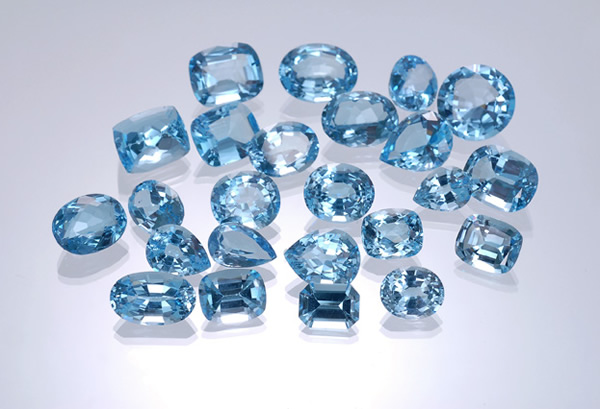 |
| Cool blue... This blue topaz, on offer by Pala International, is not treated with neutron irradiation. The color is achieved via electron beam method, which doesn’t produce unsafe residual radiation. |
Son of “Franken-stone”
Our second reader said that he hadn’t “heard, seen or measured anything factual that radioactive stones have again entered the trade channels,” and while he cautioned against a new, unwarranted “Franken-stone” scare, he felt that authorities should be contacted if new “hot” stones are identified.
Emmett responds by expressing apprehension that countries without the stringent standards of the NRC might be using neutron irradiation. “So the concern is simply, is hot material being shipped into the US as rough, cut stones, or finished jewelry? That cannot be definitively determined without measuring a lot of topaz from different foreign dealers.”
David Federman, in the April 2007 issue of Modern Jeweler, reports:
Recently, a major American jewelry manufacturer who imported blue topaz checked the radioactivity levels of a rough shipment from overseas. A good deal of the material was radioactive. “I went ballistic,” he says (on condition of anonymity). “This was stuff that I would have sent to China for cutting. The cutters there already face enough danger from silicosis by breathing in quartz dust. Now I would have added a new danger—cancer caused by radioactive topaz dust. What kind of person would put people at such risk?”
Emmett also has gotten wind of this.
It is my personal opinion that a large scale testing program would produce some unpleasant surprises. Whether any importation of neutron irradiated blue topaz is legal under NRC regulations is an interesting question which would have to be posed to the NRC for resolution. One of the dealer associations should raise the issue [with the] NRC, if they are responsible trade organizations.
Clearly, a concern over radiation levels exists. On that note, we contacted our trade insider to see if dealers had decided to take concerted action regarding self-regulation, or any other measures.
Going It Alone
As we noted in December, relatively few dealers handle blue topaz, so the issue of safety has an impact on only a handful of stakeholders. Late last year, after informal talks on the issues surrounding irradiated topaz, a group of these players decided “to approach the issue individually rather than collectively.”
Earlier this month, we asked our informant, who participated in the talks, whether anything had changed.
No new info and I really expect nothing to happen for at least a year. Unless . . . . .
Unless . . .
There’s a possibility that the marketplace itself may settle the question of whether irradiated stones get past the gatekeepers—at least in the case of blue topaz. If non-neutron-irradiated alternatives become available—and are marketed as safe and eco-friendly—the irradiated product could be marginalized. Given a clear choice, the educated dealer/consumer might opt for substitutes to neutron-irradiated stones.
Enter “diffusion topaz.” This treatment employs a process that was first applied to sapphire: powdered chemical agents are used to coat faceted white topaz, which is then placed in high-temperature crucibles. The result is not a coating so much as a very thin layer of color, fused with the stone. (For more on the process and issues involved, see Federman’s “A New Kind of Blue.”)
As our insider told us,
Signity has developed diffused blue topaz now and I think will expose the irradiated issue to promote their product as an alternative. I do not think the jewelry industry... will address it head on unless someone actually gets arrested. Who cares if it is hurting someone?
Sorry I am so negative...
Time will tell whether purveyors of diffusion topaz (or any future alternative) find it in their best interest to raise the irradiation issue in a big way as they develop their marketing. Signity, for instance, mentions that its product “contains no radiation, and is therefore safe and environmentally friendly.” But Signity also promotes non-safety-related advantages: the fact that the product “sustain[s] cast-in-place methods and cleaning processes... that cannot be applied to topaz that is irradiated or electron treated.”
What the Fuss Is About
Aside from issues of safety is the matter of how treatments are perceived by dealers and consumers. As Richard W. Hughes asked us recently:
Why do we go through the gymnastics of irradiation and diffusion treatment, when we could produce essentially the same result with synthetic spinel? Same hardness, same color... It’s because the former are, obviously, “synthetic,” whereas the latter are considered more “natural.” But are they really?
On his website, Hughes has reproduced a recent John Emmett article from Jewellery News Asia entitled “Trust: The Ethics of Gem Treatment Disclosure,” where these issues are probed. By fostering the consumer’s understanding of treatments rather than obfuscating their disclosure, Emmett says, the buyer will be informed and more likely to buy, rather than be confused and wary. Selling the stuff is what it's all about, after all.
As Emmett points out, consumers need to know that the product they’re buying is safe and that it was produced under conditions that were danger free for the person cutting it and handling it. In the case of neutron-irradiated topaz, we believe doubts about safety are significant enough for caution to be observed and maintained. We’re raising the matter here, in the hope of preventing the issue from being aired due to some future misfortune that turns out, with hindsight, to have been preventable.
As always, feedback on this story is encouraged.
 |
NRC Confronts Blue Topaz Issue
Industry Leaders to Meet with Regulatory Agency
July 23, 2007. Jewelry industry leaders will meet with the Nuclear Regulatory Commission (NRC) on July 26 to discuss irradiated gemstones in general, and imported blue topaz specifically, it was reported last week by Jewelers Circular Keystone (JCK). The meeting, which will be held in Rockville, MD, will be attended by Rick Krementz of the American Gem Trade Association, Cecilia Gardner of Jewelers Vigilance Committee (JVC), and Tim Haake of Jewelers of America. On the NRC side will be members of the Division of Material Safety and State Agreements, and the Division of Interagency Liaison and Rulemaking.
According to the NRC meeting notice the purpose of the meeting is to
- Discuss the current state of the industry regarding licensing for importation and exempt distribution of nuclear irradiated gemstones
- Discuss current inventories of irradiated gemstones
- Discuss the proposed rule on the expansion of the definition of byproduct material
JVC, in a July 19 blue topaz update, addresses the fact that the NRC requires the initial importer of nuclear (neutron) irradiated gemstones to be licensed. “Similar rules will soon be in place governing accelerator-irradiated gemstones,” the update continued. Because no licensed entity currently exists for importation, possession, or distribution of irradiated gemstones in the U.S., their presence may lie outside the law.
NRC Gathering Information
NRC public affairs officer David McIntyre, however, told JCK, “Generally these stones are not a health risk. We just want to make sure there are safeguards in place... We’re really in an information-gathering mode.” McIntyre said that the NRC’s aim is threefold:
- To “re-establish arrangements whereby somebody would apply for an exempt distribution license to be a clearinghouse for all gems coming into the country” and to insure that these gems are in compliance with regulatory limits
- To be reassured that gemstones already in distribution are safe
- To deal with upcoming regulation of accelerator-irradiated gemstone material (such as tourmaline, quartz, kunzite, and some topaz). This issue is really a subset of a larger regulatory issue, which mainly concerns medical isotopes, until recently outside the purview of the NRC
Industry Task Force
In its blue topaz update, JVC stated that the organization “has formed a task force consisting of suppliers, manufacturers and retailers, and representatives of other trade associations,” and that it would “lead a delegation to the government regulatory body governing these gemstones (the Nuclear Regulatory Commission) to address bringing the industry into full compliance.”
Presumably the July 26 NRC meeting is the first step in a welcome process that hopefully will lead to clarity on the issue of regulation of irradiated gemstones.
As always, feedback on this story is encouraged.
 |
AGTA Issues Blue Topaz White Paper
July 26, 2007. The American Gem Trade Association (AGTA) today issued a “White Paper on Irradiated Blue Topaz.” The document reviews past and current regulations, risk assessment, and outlines AGTA goals regarding the status of blue topaz and other irradiated stones. These goals include:
- Facilitation of radioactivity measurement for current inventories
- Facilitation of future legal importation of irradiated gems
- Lobbying the Nuclear Regulatory Commission on behalf of the industry
- Educational and compliance initiatives
AGTA and other industry representatives meet today with the NRC to discuss irradiation issues.
NRC Blue Topaz Meeting Summary
 |
August 1, 2007. International Colored Gemstone Association (ICA) Executive Director, Barbara Lipatapanlop, today forwarded by email to ICA members a summary of last week’s meeting between approximately 20 industry representatives (including Lipatapanlop) and officials from the U.S. Nuclear Regulatory Commission (NRC). The meeting was held July 26 at NRC offices in Rockville, Maryland, to discuss issues surrounding irradiated gemstones, including blue topaz.
The meeting summary, prepared by Jewelers Vigilance Committee President, Cecilia Gardner, is as follows:
NRC officials assured us that it was not their intention to impede the market for blue topaz. They are willing to work with the industry to assure that the product offers no health and safety risks. Once they have been assured that there are no risks to the public health or safety, they would be in a position to offer the guidance requested. They are willing to expedite the steps required.
For the NRC to provide guidance on current inventories and imports for the current Christmas selling season, they require the following:
- Applications from one or more entities to become properly licensed to import, possess and distribute these nuclear radiated gemstones
- Documentation of recent testing by industry members on blue topaz indicating the levels of radiation detectable (GIA has offered to provide their records to the NRC)
- NRC testing of current inventories for the purpose of ensuring health and safety should these inventories be offered for sale
Lipatapanlop’s email stated that documented testing results were offered to the NRC by American Gem Trade Association and the Gemological Institute of America. “I assured officials at NRC that ICA members would be willing to cooperate with them in testing current inventories of blue topaz when NRC visits New York this week. [ICA President] Joe Menzie is coordinating this with dealers in the NY area.”
The NRC is expected to issue an official summary of the meeting soon. We will post it as soon as it becomes available.
 |
NRC Tests Blue Topaz; No Health Threat, No Sign-off
Aug. 10, 2007. Colored Stone has reported on the results of U.S. Nuclear Regulatory Commission (NRC) testing of nine lots of irradiated blue topaz, conducted on August 2. The NRC “found all stones tested safe for wearing (eight of the nine samples measured at background radioactivity levels and one twice above), it is not yet ready to declare huge industry backlogs of this gem safe for selling,” according to David Federman’s August 8 story.
The story includes an exclusive statement prepared for Colored Stone by NRC official Scott Moore. It gives the clearest picture of the course being taken by the NRC and how testing fits into it.
Just the week before the NRC statement, Federman, who is Colored Stone’s Editor-in-Chief, had done a two-part, in-depth review of the irradiation issue, titled “Topaz Troubles.”
An NRC official declared that “there was nothing alarming from a public health and safety issue,” following the August 2 testing, according to an August 9 article in National Jeweler. More “survey data from the industry” is needed, however, before current inventories are declared safe.
As always, feedback on this story is encouraged.
NRC: Bride of Franken-stone No More
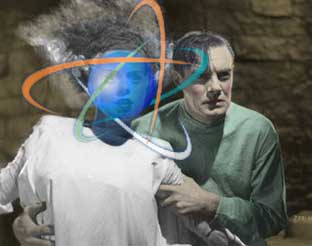 |
October 18, 2007. It being two weeks before Halloween, we just couldn’t resist the title...
Regulatory Body Developing New Rules, Certification
Today, the federal Nuclear Regulatory Commission issued a transition plan whereby it will assume regulatory responsibility for irradiated material previously managed by the states. The issuance of new rules regarding irradiation of gemstones, including blue topaz, is the latest in a flurry of activity by the body in the last few months.
Like a compliant bride to the blue topaz trade, the NRC until recently had quietly ignored its own regulations in regard to enforcement. Co-dependent no more, as recent articles in Colored Stone and Modern Jeweler indicate, the regulatory agency is taking the issue of gemstone irradiation seriously. They are, in fact, extending regulation to accelerator-treated stones as well as nuclear reactor-irradiated material. Certification of topaz stocks is a possibility as well. But first, some recent history...
‘Is Blue Topaz Illegal?”
This is the question asked by Cheryl Kremkow, Editor-in-Chief of Modern Jeweler, in the magazine’s August 2007 issue. The article begins by stating that all 1,332 Sterling Jewelers stores across the country had removed blue topaz in June. “The action was in response to a May 24 certified letter that the Nuclear Regulatory Commission sent to major jewelry retailers across the country, including Wal-Mart and J.C. Penney, alerting them to the fact that the NRC requires irradiation facilities and importers of neutron-irradiated topaz to be licensed.” Pala International, in fact, received a query from a J.C. Penney fine jewelry associate on July 14: “On Wednesday we got a memo to pull all blue topaz because of a possible quality issue. No one is giving any information regarding this action.”
The NRC letter asked retailers to send a list of their topaz suppliers to the NRC; it also asked whether the topaz had been treated by neutrons or electrons. According to the article, the letter caused Sterling Jewelers to investigate the rules. They decided to pull the stones while their suppliers complied with those regulations.
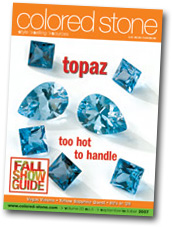 |
| Still a “hot” topic. Blue topaz was the subject of recent articles in Colored Stone and a report by AGTA’s Gemological Testing Center. Read more here. |
Playing It Safe
Colored Stone Editor-in-Chief David Federman’s online article, “Blue Topaz: The Ban That Never Was,” discusses whether the Nuclear Regulatory Commission (NRC) had in fact required retailers to suspend sales of blue topaz. When Colored Stone heard it rumored that the NRC was approving some major retailers to sell blue topaz, the magazine put the question to the NRC’s press officer, who denied that a ban was ever in effect.
Nonetheless, the letters retailers received from the NRC, as well as a Jewelers Vigilance Committee summary of an NRC–industry meeting in July, gave many retailers pause. An irradiator quoted in the article explains: “Creating fear and hysteria was [the NRC’s] way to get worrisome topaz off of shelves without having to commence expensive policing actions. In the mean time, they could assure themselves that existing inventories were, by and large, safe.”
Certification?
The Colored Stone article states that “very shortly, perhaps by the end of October, retailers will have to certify remaining topaz stocks—as well as any and all replacement goods, as the NRC grants the first licenses for exempt distribution of topaz.” The article goes on to examine who might perform certification, standards and limits, and cost. A September 2007 Modern Jeweler article, “Blue Topaz: A Path Forward,” covers some of the same ground.
Regulation of Accelerator-Irradiated Stones
While much of the information on the NRC’s website doesn’t address gemstone irradiation specifically, the following FAQ (from a list of import–export licensing FAQs) does do so. It actually discusses regulation of accelerator-treated stones as well as those irradiated by nuclear reactors.
At present, although accelerator irradiated gemstones are not subject to NRC regulations, NRC is currently in the process of revising its regulations to change this. Certain radium sources, accelerator-produced materials, and certain naturally occurring radioactive material will become subject to NRC regulation when the final rule is published. This is expected in the late fall or by the end of 2007. To monitor the status of this action, please check the NRC website.
In the meantime, we recommend that anyone planning to import accelerator irradiated gemstones into the United States should check with the States into which the material will be imported, possessed, and distributed for any applicable requirements. In addition, because the source of radiation (accelerators or reactors) cannot be distinguished once the gemstones leave the facility, it is also recommended that importers include documentation indicating that the gemstones were ONLY exposed to radiation in an accelerator, and not in any reactors. It is common for some types of blue topaz to be exposed to both accelerators and neutron radiation, or neutron radiation alone. Documentation attesting to the nature of the irradiation should help in clarifying any questions of regulatory oversight.
Once the rule amending the definition of byproduct material becomes final and effective, and the waivers granted to States to regulate these materials are terminated, accelerator produced radioactive material will come under NRC's jurisdiction (appx. late fall/winter 2007 for about 40 of the 50 States, and within the following 2 years in the remaining 10 States, for exempt distribution licensing). At that point, NRC will regulate accelerator irradiated gemstones in the same fashion that it currently regulates neutron (reactor) irradiated gemstones. In other words, a party located in the U.S. would need to obtain an exempt product distribution license from NRC to authorize the initial distribution of accelerator irradiated gemstones in the U.S. [Page dated September 12, 2007]
On October 1, the NRC published a final rule “expanding the definition of radioactive materials subject to its regulatory authority” (to include accelerator-irradiated material). Interested parties can keep abreast of the NRC’s progress on the transition implementation in the NRC’s Naturally-Occurring and Accelerator-Produced Radioactive Material (NARM) Toolbox—that is, if you can decipher the legalese.
Other Irradiated Material
As we’ve noted before, blue topaz may be at the center of the issue, but it is not the only material to be irradiated. The August Modern Jeweler article observes that because the new regulations
will apply to all materials irradiated in an accelerator, not just topaz, they may also require importers to be licensed to import any other gems irradiated in an accelerator. That includes irradiated diamonds. It may also include some green quartz/prasiolite, lemon citrine/oro verde, smoky quartz, golden beryl, kunzite, morganite, and tourmaline.
Who Cares?
When we received a tip last December that this issue might be worthy of consideration, we were asked “Why bother focusing on material that’s so small potatoes?” It’s true that the per-carat price of blue topaz would not keep the purveyors of fine colored gemstones at Pala International gainfully employed if that were our stock in trade. But little things do add up. As David Federman mentions at the close of his article, “the fact that blue topaz jewelry accounts for an estimated $1.5 billion in annual U.S. retail sales” means that someone somewhere is buying an awful lot of this relatively inexpensive gemstone.
As we’ve maintained from the outset, the issue of irradiated material—whether lowly blue topaz or something with more cachet—could have significant impact on the trade were an avertable scandal to break. Now that the NRC has thrown off the veil as Franken-stone’s bride, sweeping the cobwebs off twenty-year-old regulations, the risk of scandal has a good chance of being avoided. Trade input and cooperation are key in this new effort, of course, and have been taking place.
So we can have cautious optimism, but let’s not forget that regulation at home doesn’t necessarily mean regulation abroad. The issue is safety—of handlers and cutters, sellers and consumers—at each step of the way. We can’t afford to let the cheery light of licensing and certification cause us to neglect what might still lurk in the shadows. [back to top]
As always, feedback on this story is encouraged.
NRC Won’t Take Action on Blue Topaz Inventories
 |
December 16, 2007. The Nuclear Regulatory Commission (NRC) has decided against taking action on current inventories of blue topaz, it was reported by National Jeweler on December 7.
While the NRC has been putting into place revisions of regulations regarding irradiated gemstones, including blue topaz, the fate of existing inventories was uncertain for months. An NRC spokesman told National Jeweler that the agency was employing “enforcement discretion” in the case of existing stock of blue topaz.
On December 4, the NRC updated its Naturally-Occurring and Accelerator-Produced Radioactive (NARM) Toolbox, which contains regulatory information on irradiated material, including gemstones. [back to top]
NRC Issues Distribution Licenses for Irradiated Gemstones
December 16, 2007. On November 8, the NRC announced that “[t]wo distribution licenses have now been issued for neutron-irradiated topaz, and other applications are being reviewed.” The licenses are mentioned in the agency’s “Fact Sheet on Irradiated Gemstones.” The fact sheet includes answers to frequently asked questions for consumers as well as jewelers and distributors.
In a press release dated November 9, the trade organization Jewelers of America named the licensees as being Ideal Source Quality Assurance in Columbia, MO, and HBM Virginia in Warrenton, VA.
A now-deleted eBay forum thread from October 25 includes posts by former AGTA president Rick Krementz, who stated that his “facility for testing irradiated gemstones” will be licensed in January 2008. [back to top]
As always, feedback on this story is encouraged.
Radiation Safety Consultant Addresses Blue Topaz
 |
RIT expert says blue topaz stocks are safe
January 16, 2008. Last fall, JCKonline articles by Gary Roskin carried two remarks by Dr. Andrew Karam, of Rochester Institute of Technology, regarding the safety of irradiated topaz. Dr. Karam has worked as a radiation safety consultant as part of the Nuclear Regulatory Commission’s (NRC) recent efforts to address the irradiation issue. In response to a September 11 story on the subject, Dr. Karam posted the following.
I’ve been working on the NRC and state licensing issues with a company that imports a lot of blue topaz. There are a few things about this that are worth pointing out: First, I’ve gone through the scientific literature, I’ve seen radiation safety reports from the producers, and I’ve done a lot of calculations of radiation dose rates. With all of this, I think it’s safe to say that there is NO RISK to anyone from blue topaz. No risk to the importers, no risk to the shippers, and no risk to anyone wearing the jewelry.
Dr. Kumar went on to explain in a nutshell the regulatory and bureaucratic process of licensing distributors who can validate the safety of irradiated material.
Dose example
In a November 1 article, Dr. Karam gave an example of the dose of radiation obtained by wearing jewelry containing irradiated gemstones.
[Dr. Karam] says a blue topaz bracelet with 6.00 cts. of reactor-irradiated gemstones would produce a radiation dose between 700 and 800 mrem (millirems) if worn continuously for a year after being irradiated but notes that’s less than regulatory limits. “This level of radiation exposure poses no risk to the wearer,” Karam says. “They will not get radiation burns, they will not get cancer, and they don’t have to worry about radiation affecting a pregnancy.”
Regarding jewelry industry workers, Karam used the example of a worker spending 1,000 hours annually “in an area with huge quantities” of blue topaz. According to the article, this scenario “would still be far from a level of exposure that’s likely to cause cancer or any other ill effects.”
The dangling conversation...
In a song written for a 1966 Simon and Garfunkel album, Paul Simon writes of how “we speak of things that matter,” but ultimately, “we are verses out of rhythm / couplets out of rhyme.” Lost in the dangling conversation.
We’re reassured by NRC regulatory action and likewise by Dr. Karam’s remarks. But, of course, NRC statutes and an expert’s dosage estimates don’t address (and plainly aren’t meant to address) the issue of worker safety abroad—during the handling, cutting, and polishing of irradiated material. We’ve come a long way in thirteen months. But we can’t ignore the fact that the conversation remains open, dangling. [back to top]
As always, feedback on this story is encouraged.
Irradiated Topaz: Something old, something new, something borrowed, something blue
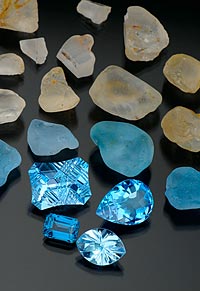 |
| Virtually colorless topaz rough (above) is irradiated and then heated to turn blue (middle layer of rough). Photo by Robert Weldon, © 2007 Gemological Institute of America. |
February 21, 2007. These two items on the subject of irradiated topaz came across our desk over the last couple of months. Everyone seems to be upbeat about this year’s prospects.
- Blue Topaz: Now Street Legal by Modern Jeweler Editor-In-Chief Cheryl Kremkow, explains that the three companies licensed by the Nuclear Regulatory Commission for distribution of irradiated gems are affiliated with major blue topaz producers, thus facilitating a rapid flow of such stones into the market. That market is estimated at 24–60 million carats in the U.S. Prices have increased, but of course the stones were inexpensive to begin with…
- Irradiated Blue Topaz: Now What? by Colored Stone Associate Editor Karla A. Rosenbusch, begins with a prediction: “Blue topaz is going to once again become a cornerstone of the colored stone business.” Given the imprimatur of Nuclear Regulatory Commission licensees, blue topaz can be distributed with safety concerns allayed, according to the article.
And Palagems.com is pleased to host a reprint of Robert Weldon’s Topaz Blue & Déjà Vu. First released late last summer by the Gemological Institute of America, it contains a clear and crisp discussion of the history and science of gemstone irradiation, up to the point of recent Nuclear Regulatory Commission actions. Beautifully illustrated with Weldon’s own photographs. [back to top]
As always, feedback on this story is encouraged.
Irradiated Gemstones: Licensee Announced,
Guidelines Released
NRC Awards Distribution License to PAJ
August 21, 2008. Prime Art & Jewel, of Dallas, Texas, has been issued an “exempt distribution license” by the Nuclear Regulatory Commission (NRC), allowing it to distribute irradiated gemstones, including blue topaz, according to a July 15 story at JCKonline. While three other licensees are listed by the NRC, PAJ claims to be the first U.S. jewelry wholesaler to receive such a license. [back to top]
NRC and AGTA/JVC Guidelines:
Government Presentation and Industry Brochure
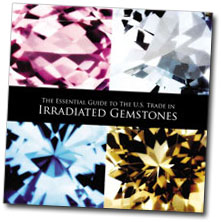 |
August 21, 2008. In case you missed it at the Tucson show last February, the Nuclear Regulatory Commission’s presentation is available. The presentation, which was delivered on February 8 by NRC Senior Health Physicist Joseph E. DeCicco, has been added to a list of FAQs regarding irradiated gemstones, which we reported on last December.
“The Essential Guide to the Trade in Irradiated Gemstones” is a brochure co-authored by Jewelers Vigilance Committee and American Gem Trade Association. It includes the following topics.
- NRC Regulations and Licensing
- Initial Possession of Irradiated Gemstones
- Distributing Irradiated Gemstones or Jewelry Containing Irradiated Gemstones
- Retail Sales in the U.S. of Irradiated Gemstones or Jewelry Containing Irradiated Gemstones
- Manufacturing Jewelry in the U.S. with Irradiated Gemstones
- Manufacturing Jewelry with Irradiated Gemstones Outside the U.S.
- Must Licensed Importers, Possessors and Distributors Own the Goods that they Import, Possess or Distribute?
- Can the License Holder be Located Outside the U.S.?
- Do the NRC Regulations Apply to Finished Product Containing Irradiated Gemstones?
- Frequently Asked Questions
[back to top]
As always, feedback on this story is encouraged.
Irradiated Gemstone Testing License Issued
Rick Krementz’s GemClear lab receives NRC certification
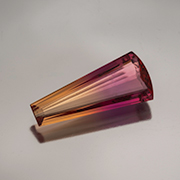 |
| Of course, you won’t find blue topaz at Pala International, but we can offer this bi-color from Brazil. Inventory #15507. |
October 22, 2008. GemClear LP announced, on September 22, receipt of a license by the Nuclear Regulatory Commission to test radiation in gemstones such as blue topaz. GemClear becomes “the first independent ‘third party’ laboratory” to be licensed by the NRC, according to a press release sent to Pala International.
A press release issued today stated that GemClear had identified non-compliant—but not dangerous—irradiated blue topaz, from a New York dealer.
GemClear, based in Farmers Branch, Texas, is headed by Rick Krementz, a former president of American Gem Trade Association. News of Krementz’s plans for a testing laboratory first surfaced a year ago—and somewhat controversially so—in Gary Roskin’s blog.
The September 22 press release states that GemClear’s testing technology is to be patented and that the firm has plans to open facilities in Bangkok and Hong Kong. The issue of overseas gemstone irradiation is one we raised in December of 2006.
The fact that gemstone-enhancing nuclear reactors are, as we understand it, proliferating in countries that may not adequately restrict the flow of “hot” material leads us to believe that the issue of safety will become more—not less—acute.
Establishment of testing facilities abroad—assuming such facilities adhere to NRC standards—is a welcome step in the right direction. Such testing, when performed on rough material, prior to exposure by cutters to dust, is an obvious and important safety measure. [back to top]
As always, feedback on this story is encouraged.
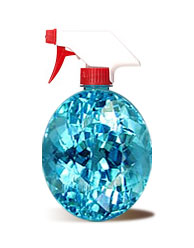 |
| Swiss blue (aka “Windex blue”) topaz has not been pulled from shelves as vigorously as darker shades, according to Clary. |
Market Blah about Topaz Blue
November 19, 2008. Just about a year ago, the Nuclear Regulatory Commission announced the first distribution licenses for neutron-irradiated topaz. The action came after nearly a year of looking into the issue of (re)regulation of irradiated material, which we began reporting on in December 2006.
Now, according to Colored Stone’s Jordan Clary, the initial drop-off in sales of blue topaz has not been followed by a rebound, even after the NRC licensing of six testing labs and distributors.
Clary discusses in detail the issues surrounding this trend with dealers, licensees, trade org reps, and more. [back to top]
As always, feedback on this story is encouraged.
Déjà blue all over again
October 18, 2011. The edition of Journal of Gemmology featuring the article on chrysoberyl growth patterns, which we referred to above, also contains an article that reminded us of an industry concern that we covered a few years ago.
 |
In “A Russian Maxixe beryl?” (abstract here) researcher Lars Olov Andersson states that colorless Russian beryl, when irradiated, could display the deep blue color of Maxixe beryl.
Immediately we were reminded of the issue of blue topaz irradiation, which we raised nearly five years ago, in a series of articles. The next-to-last in that series announced that former AGTA president Rick Krementz had been licensed by the Nuclear Regulatory Commission to test gemstone radiation. The lab, which goes by the name of GemClear, has suspended operations, according to a September 21 article in National Jeweler. The reason: Krementz said the NRC “unofficially” has ceased enforcement of its own regulations on irradiated colored stones. Shades of listeria-laden canta—er—loupe?
As the article notes, in July the Jewelers Vigilance Committee began giving the trade “a refresher course” on the regulations. Brush up on it here. [back to top]
As always, feedback on this story is encouraged.
Gems & Gemology: Blue Topaz
March 15, 2012. We couldn’t resist this. The current issue of Gems & Gemology includes an article by Jian Zhang, Taijin Lu, Manjun Wang, and Hua Chen: “The Radioactive Decay Pattern of Blue Topaz Treated by Neutron Irradiation.” The team studied 15 neutron-irradiated blue topaz samples. The decay pattern of the samples was determined and the time for decay to safe levels was calculated. The results? Most of the material was safe when first measured at 95 days after leaving the reactor, but some samples indicated that it would be years before they would be safe, due to higher concentrations of radionuclide impurities. [back to top]
As always, feedback on this story is encouraged.